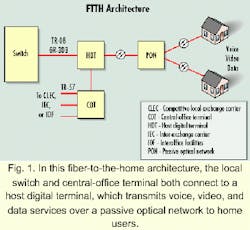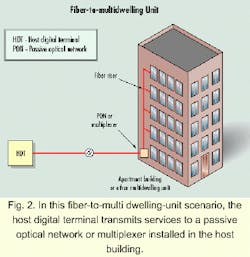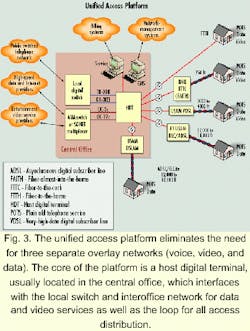Fiber gains ground in access networks
The transition to a full-service network is driving fiber closer to home, increasing the need for deployment of fiber-to-the-node and fiber-to-the-curb architectures.
| In this article: |
|---|
| Fiber is required |
| Why a unified access platform? |
| System architectures |
| Customer-premises equipment |
| Cost-effective fiber strategies |
CLECs are leasing infrastructure and building new plants to provide telephone and data services, mostly in densely populated areas. Facilities, financing, and expertise is increasingly gained through acquisitions and mergers, including the recently approved AT&T/TCI deal. The cable industry essentially has a broadband network that now needs to be modified to carry narrowband telephony and data traffic.
The telephone industry, on the other hand, has a very reliable narrowband network that needs to exploit a multibillion-dollar infrastructure to carry broadband and high-speed data traffic. These capabilities will require the application of several architectures that employ fiber in the access network: fiber-to-the-node (FTTN), fiber-to-the-curb (FTTC), and ultimately, fiber-to-the-home (FTTH). Each of these architectures will have an application and transition strategy. Central-office solutions using the existing twisted-copper pairs are good for high-speed data applications but generally do not get close enough to the customer to offer broadband services. FTTC provides the largest bandwidth capacity and is being deployed today in new developments and rehabilitation areas.
As robust and futureproof as FTTC is, it generally cannot be deployed cost-effectively for entire franchise areas. Clearly, the most cost-effective solution for passing as many homes as possible in the shortest period of time is the FTTN solution using very-high-data digital-subscriber-line (VDSL) technology. Since, in all likelihood, each of these architecture configurations will apply to the serving area, it is important that each is provided on an integrated platform for hardware, software, and operational support systems.The ultimate goal in most technologists' and service providers' minds is an FTTH architecture (see Figs. 1 and 2). FTTH can offer almost limitless bandwidth, ensuring a futureproof network. This architecture can provide on-demand services and bandwidth from a single element network. And it is probably the lowest-maintenance design. The key to the economic deployment of FTTH is a low-cost optical-to-electrical (O/E) terminal at the home and power provisioning by the customer. Once these issues and regulatory concerns such as lifeline services are addressed, FTTH will be rolled out on a full-deployment basis for new builds and existing networks that require rehabilitation.
Since a complete replacement of the existing infrastructure is not feasible and FTTH is not quite here yet, a "transitional" strategy is required. The goal of this strategy is to position the network for the "ultimate" design and to offer the most robust suite of services and bandwidth to as many customers' homes as possible. The transitional plan will drive fiber deeper into the network by using FTTC for new-build and rehabilitation areas and FTTN for growth and new services where the copper distribution plant is available and in good condition. Digital-subscriber-line technology makes it possible to exploit the copper distribution network. It provides high bandwidth over the last few thousand feet and reuses the embedded copper plant, ensuring a rapid deployment to the maximum number of homes for the lowest cost.Using this strategy, access is gained to each customer in the distribution area. Equipment (service plug-ins) can be provided as the demand for service materializes. Revenues are generated immediately to help finance the continued deployment into other areas. An important benefit of this strategy is that all services can be consolidated into one unified access platform.
The unified access platform eliminates the need for three separate overlay networks (voice, video, and data) and reduces the cost for equipment, administration, operation, and maintenance. The core of the platform is a host digital terminal (HDT), usually located in the central office, that interfaces with the local switch and interoffice network for data and video services and the loop for all-access distribution. It also uses the embedded copper twisted-pair, as appropriate, to ensure rapid deployment at the lowest cost. Once the platform has been deployed, services can be provisioned in a plug 'n play process tying cost more directly with revenues (see Fig. 3).
The three system architectures for the loop are FTTN, FTTC, and FTTH, each having its applications and benefits in the transition of the network, and each provides a critical link for the cost-effective evolution of the full-service network.
The benefit of FTTN is it starts the initial drive to push fiber further into the network. It establishes an access platform for providing telephone, high-speed data, and video services to the maximum number of homes but does not require a complete rebuild of the loop and distribution networks. Services are provided "just in time" by installing a plug-in at the fiber node, according to demand. FTTN overlays and exploits the existing copper distribution network until services or rehabilitation move the fiber node to the curb (FTTC) or into the home (FTTH).
The major requirement for this architecture is that nodes must be established at the distribution-area level within 4000 to 5000 ft of the homes for broadband or video services. Generally, the fiber nodes in the network today serve a carrier serving area (CSA) that can be up to 12,000 ft from the home. Therefore, it will be necessary to engineer three to five FTTN sites per CSA. The good news is the technology, both from a physical infrastructure (cabinets, power, facilities) and services perspective, offers a cost-effective solution.
FTTC, or FAITH (fiber-almost-into-the-home), has several advantages over FTTN architectures. When FTTC is used for rehabilitation of existing plant, it eliminates cable transfers and cut sheet inaccuracies. It also drives the fiber much deeper into the network, reducing the potential for trouble reports and the deterioration of the plant due to field activity. FTTC is the most robust, "deployable" architecture today, and it positions the network for the evolution to FTTH. It is also the most cost-effective strategy for new-build and rehabilitation areas.
One of the drawbacks to this architecture is that a copper power grid is required in addition to the fiber. A centrally located remote powering system will power 50 to 100 curbside optical network units. Individual power nodes at each curb site are expensive and cannot provide the long-term service required in prolonged power outages.
FTTH, the ultimate network for providing fiber into the home, eliminates the entire copper infrastructure-feeder, distribution, and drop plant. This architecture offers the most robust and futureproof solution for all bandwidth applications. It also eliminates all the maintenance and finite life expectancy that copper has historically demonstrated.
The two key items preventing the general deployment of FTTH are the cost of the optical terminal in each home and the provision of power by the customer. However, the cost of the O/E terminal in the home is dropping quickly. More dramatic cost reductions are expected as actual deployments begin and volumes increase.
The provision of power is somewhat convoluted due to possible regulatory issues for lifeline services. This requirement may differ depending on the service provider. Backup batteries, battery monitoring, and replacement are just some of the issues that need to be addressed. The customer also needs "conditioning" to these same issues. Limited field trials are currently underway to evaluate the architectural configurations and examine the acceptance of the powering options.
The final link in the network is the customer-premises equipment. At the home, a network-terminating device is required to convert the broadband and data streams to acceptable video signals (National Television Standards Committee-NTSC) or data connections (10-megabit-per-second Ethernet). Two devices can be used: an asymmetrical digital subscriber line or G.Lite modem for data services and Internet access, or a VDSL residential gateway that terminates higher bandwidths for both video and data services.
Like the HDT in the central office, the residential gateway (RG) device is the platform for all of the in-home services. It provides the connection to the network and distributes the full range of services to the network elements throughout the home. The RG device is the network interface for all architectures--FTTN, FTTC, and FTTH-and therefore allows for a smooth transition from each of the configurations.
Whether the network is FTTN, FTTC, or FTTH, fiber is the key to a successful architecture regardless of deployment applications. Deployment of a full-service network is necessary to compete for new customers and retain current customers in a very competitive marketplace as well as to offer new services and revenues.
Telephone companies benefit from this strategy with quick deployment of video and data services. A cost-effective transition plan can be instituted to gain broadband customers to generate revenues and optimize the customers served.
Competitive access providers can benefit as well with a quick entry into a market area. They can provide for all services from a single platform and maximize the "take away" from the incumbent providers.
Each of the architectures discussed here is being deployed today. The business cases and empirical data demonstrate cost-effective fiber strategies whether the deployment is as a narrowband infrastructure with broadband options or a broadband infrastructure with narrowband options.
Gordon McKenney is the director of technology planning at Next Level Communications (Rohnert Park, CA).



